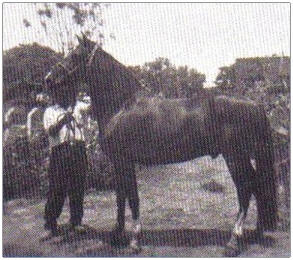|
|
Sol de Oro (V) -
famous Peruvian
Pasos
 Sol
de Oro (V) - Destined for Greatness Sol
de Oro (V) - Destined for Greatness
Based on an article
written by Brenda Imus entitled "Predestined for Greatness"
from 1993
The horse who is considered by
many to be the greatest Peruvian Paso sire of all time was
southern Peru's Sol de Oro. This horse might well have lived out
his life as a crippled scrub horse in the mountains of southern
Peru, had it not been for a man by the name of Gustavo de la
Borda. The discovery and subsequent use of Sol de Oro is another
of those stories bordering on miraculous.
In the early 1920's, Peru along with the rest of the world,
entered the Machine Age. When the Pan-American Highway came
through Ica in the 30's, southern Peruvians' need for good
riding horses was diminished. Since southern haciendas were much
smaller than their northern counterparts, farmers of that region
were easily able to replace the horse with modem equipment.
Unfortunately, this was the area known for the finest Peruvian
Paso bloodlines. Once horses became little more than a hobby,
many of them sold cheaply into the hands of peasant farmers with
lands located in the canyons, or quebradas, of southern Peru.
The rough mountainous terrain of this area still required the
use of horses. The geographical isolation of the quebradas
ensured that the southern bloodlines were preserved, and even
intensified through line breeding - though the size and
condition of the horses declined as a result of casual care and
poor nutrition.
Gustavo de la Borda was a son of Jose de la Borda, one of the
few southern Peruvian men who still valued fine horses during
this period. Upon his father's death Gustavo inherited his
father's horses. At about this time horse shows were becoming
popular, and it was a great disappointment to Gustavo de la
Borda and other southern breeders that all of the top prizes at
these competitions went to breeders from northern and central
Peru. This was a hard pill to swallow for these horsemen, as in
the past southern Peru was well known for producing the best
Peruvian Pasos in the country.
Gustavo de la Borda gradually came to the belief that many of
the bloodlines that had been lost to southern breeders were
still conserved in the quebradas. Fueled by this belief, Gustavo
began traveling up and down the mountains and canyons in search
of good bloodstock to bring back to his farm on the coast. On
one of these journeys Gustavo discovered a stallion that was in
sorry shape. One foreleg had been broken when the horse was
roped from a mountainside field at the age of three years. The
limb had healed crookedly, and caused the horse some pain. The
stallion was considered worthless by his owners, since he
couldn't be ridden; therefore he had received very little
attention or care. The current owner couldn't tell how old the
horse was, from what farm he originated, or who had been his
sire. Such facts seemed irrelevant to the farmer, especially
when considering such a sorry specimen of horseflesh.
But Gustavo de la Borda's practiced eye told him that despite
outward appearances, here was a stallion with great potential.
He paid the owner two hundred dollars for the crippled animal.
The farmer who sold Gustavo the horse considered this buyer to
be crazy and, once they saw the stallion Gustavo brought out of
the mountains, most of Gustavo's peers in the horse breeding
business agreed with this assessment. They ridiculed him for
using such a stallion on his mares, and one prominent judge
referred to the horse as "a strong box on legs." Only two other
breeders, Jose "Pepe" Musante and Alfredo Elias, Gustavo's
brother-in-law, shared his enthusiasm for the damaged stud.
Gustavo was generous in sharing the services of Sol de Oro with
these other breeders.
After Pepe Musante's first crop of foals from Sol de Oro,
however, his enthusiasm was tempered for a while, and he gelded
the only male among them. But Alfredo Elias never lost faith in
the stallion. As the show ring success of Alfredo Elias's horses
began to amply substantiate Gustavo's high opinion of Sol de
Oro, breeders from all over Peru requested, and received, his
services and get for their breeding programs. It was largely due
to don Gustavo's outstanding generosity that the prepotent
stallion sired so many fine horses during the time that was left
him - though that was plenty of time, as the best estimates as
to Sol de Oro's age put the hardy little stallion at thirty
years when he died. Gustavo de la Borda's wisdom in rescuing
this horse from his mountainside prison has been proved over and
over again through the years. Every National Champion of
Champions in Peru since 1961 has carried Sol de Oro (V)'s blood;
it has also flowed through every U. S. Champion of Champions
since 1973.
More Famous Peruvian Pasos
La Zapata
-
Limeņito
Piloto
Soberano
More
about the Peruvian Pasos
History
Bloodlines
Paso Llano, Termino and Brio
Our
Pasos at Fayebrook Farms
|
|
|
|

 Sol
de Oro (V) - Destined for Greatness
Sol
de Oro (V) - Destined for Greatness